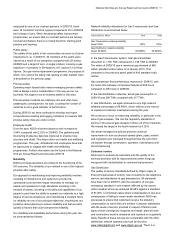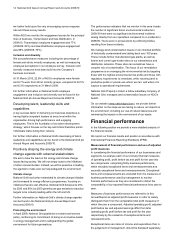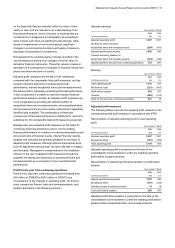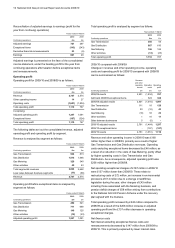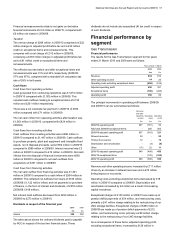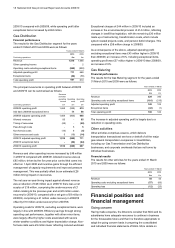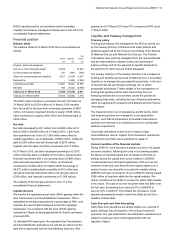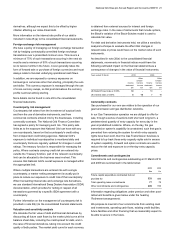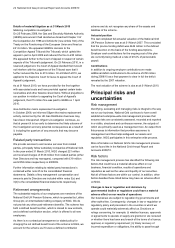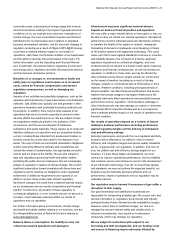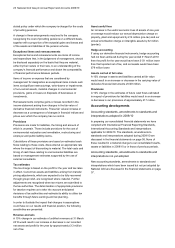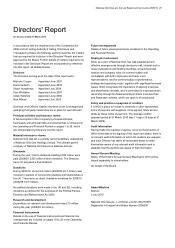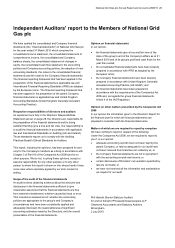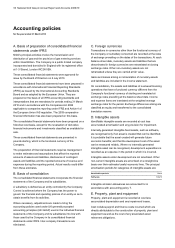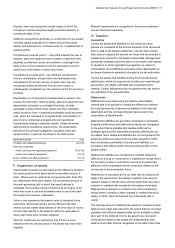National Grid 2010 Annual Report Download - page 23
Download and view the complete annual report
Please find page 23 of the 2010 National Grid annual report below. You can navigate through the pages in the report by either clicking on the pages listed below, or by using the keyword search tool below to find specific information within the annual report.
National Grid Gas plc Annual Report and Accounts 2009/10 21
derivatives, although we expect this to be offset by higher
inflation affecting our index-linked debt.
More information on the interest rate profile of our debt is
included in note 28 (a) to the consolidated financial statements.
Foreign exchange risk management
We have a policy of managing our foreign exchange transaction
risk by hedging contractually committed foreign exchange
transactions over a prescribed minimum size. This covers a
minimum of 75% of such transactions occurring in the next six
months and a minimum of 50% of such transactions occurring
six to twelve months in the future. Cover generally takes the
form of forward sale or purchase of foreign currencies and must
always relate to forecast underlying operational cash flows.
In addition, we are exposed to currency exposures on
borrowings in currencies other than sterling, principally the euro
and dollar. This currency exposure is managed through the use
of cross-currency swaps, so that post derivatives the currency
profile is almost entirely sterling.
More details can be found in note 28 to the consolidated
financial statements.
Counterparty risk management
Counterparty risk arises from the investment of surplus funds
and from the use of derivative instruments, and from
commercial contracts entered into by the businesses, including
commodity contracts. The National Grid Finance Committee
has agreed a policy for managing such risk. This policy sets
limits as to the exposure that National Grid can have with any
one counterparty, based on that counterparty’s credit rating
from independent credit rating agencies. National Grid’s
exposure to individual counterparties is monitored daily and
counterparty limits are regularly updated for changes in credit
ratings. The treasury function is responsible for managing the
policy. Where contracts carrying credit risk are entered into
outside the Treasury function, part of the relevant counterparty
limit can be allocated to the business area involved. This
ensures that National Grid’s overall exposure is managed within
the appropriate limit.
Where multiple transactions are entered into with a single
counterparty, a master netting arrangement is usually put in
place to reduce our exposure to credit risk of that counterparty.
When transacting interest rate and exchange rate derivatives,
we use standard International Swap Dealers Association (ISDA)
documentation, which provides for netting in respect of all
transactions governed by a specific ISDA agreement with a
counterparty.
Further information on the management of counterparty risk is
provided in note 28(c) to the consolidated financial statements.
Valuation and sensitivity analysis
We calculate the fair value of debt and financial derivatives by
discounting all future cash flows by the market yield curve at the
balance sheet date, including the credit spread for debt, and in
the case of financial derivatives, taking into account the credit
quality of both parties. The market yield curve for each currency
is obtained from external sources for interest and foreign
exchange rates. In the case of instruments that include options,
the Black’s variation of the Black-Scholes model is used to
calculate fair value.
For debt and derivative instruments held, we utilise a sensitivity
analysis technique to evaluate the effect that changes in
relevant rates or prices would have on the market value of such
instruments.
As described in note 28(e) to the consolidated financial
statements, movements in financial indices would have the
following estimated impact on the financial statements as a
consequence of changes in the value of financial instruments.
Years ended 31 March 2010 2009
Income
statement
£m
Othe
r
compre-
hensive
income
£m
Income
statement
£m
Othe
r
compre-
hensive
income
£m
UK Retail Prices Index ± 0.50% 10 - 10 -
UK interest rates ± 0.50% 5 16 716
Commodity contracts
Gas purchased for our own use relates to the operation of our
gas transmission and gas distribution networks.
In our Gas Transmission operation we are obliged to offer for
sale, through a series of auctions both short and long term, a
predetermined quantity of entry capacity for every day in the
year at predefined locations. Where, on the day, the gas
transmission system’s capability is constrained, such that gas is
prevented from entering the system for which entry capacity
rights have been sold, then the Gas Transmission business is
required to buy back those entry capacity rights sold in excess
of system capability. Forward and option contracts are used to
reduce the risk and exposure to on-the-day entry capacity
prices.
Commitments and contingencies
Commitments and contingencies outstanding at 31 March 2010
and 2009 are summarised in the table below:
2010 2009
£m £m
Future capital expenditure contracted but not
provided for 533 480
Total operating lease commitments 77 75
Other commitments and contingencies 209 150
Information regarding obligations under pension and other post-
retirement benefits is given below under the heading
‘Retirement arrangements’.
We propose to meet all of our commitments from existing cash
and investments, operating cash flows, existing credit facilities,
future facilities and other financing that we reasonably expect to
be able to secure in the future.


